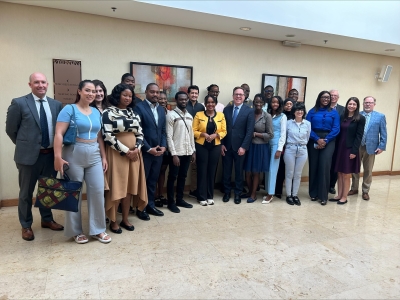NTIA Blog
Demonstrating compliance with the Buy America requirement
Tracking Project Progress in the Middle Mile Program
By: Sarah Bleau, Director of the Middle Mile Program, NTIA
Across six Internet for All grant programs, NTIA is already funding hundreds of individual projects, with hundreds more to come. A new type of data dashboard shows how the public can monitor the progress of construction and implementation related to projects in their area.
Careful monitoring and oversight of grantees is key for ensuring timely execution of funded projects and minimizing the risk of waste, fraud, and abuse. NTIA has built regular reporting requirements into its grant programs, and these new dashboards will give the public increased transparency into those reports.
The Enabling Middle Mile Broadband Infrastructure Program is the subject of the first dashboard to launch. The objective of the program is to build new or more resilient middle mile networks so that high-speed Internet service can be made available and affordable for everyone in America. It is the force multiplier for the Broadband Equity, Access, and Deployment (BEAD) Program, lowering the cost of deployment of so-called “last mile” infrastructure that connects peoples’ homes to the Internet.
Important Ideas to Streamline Broadband Permitting and Support Internet for All Deployments
By Jill Springer, Senior Advisor, Office of Internet Connectivity and Growth, NTIA
High-speed Internet service connects and builds communities, accelerates economic progress, and enhances public service capabilities. Installing broadband infrastructure can be complex due to permitting processes and regulations that may influence the availability of public rights-of-way, poles, conduits, ducts, and other necessary facilities.
Navigating federal, state, and local permitting requirements may pose challenges for NTIA grantees and subgrantees, particularly for small ISPs, electric co-ops, community-based organizations, and others with limited resources, which can result in deployment delays. States and territories will play a pivotal role in helping to close the digital divide in the United States and can work to streamline their permitting processes to improve deployment efficiency.
Constructing the Digital Landscape: Highlights of NTIA’s Middle Mile Program
By: Sarah Salgado, Broadband Program Specialist, Office of Internet Connectivity and Growth
Generations before us built infrastructure such as electricity, water, and sewer systems to serve everyone in America. Now, it is our generation’s turn to connect everyone in America to the tools they need to thrive in the modern digital economy through reliable, affordable, high-speed Internet service. Achieving this ambitious goal requires the development of middle mile infrastructure.
In 2023, NTIA awarded nearly $980 million to deploy over 12,500 miles of new middle mile fiber through the Enabling Middle Mile Broadband Infrastructure (Middle Mile) Program to 36 organizations across 40 states and territories. This investment will build new and resilient Internet highways that help lower the cost for last-mile providers to deploy future networks and increase end users' access to reliable, affordable, high-speed Internet service.
NTIA recently announced the first Middle Mile Program grantee in the nation to begin construction. Most of these grant projects are currently under environmental review, and NTIA expects additional grantees to be able to start construction on the first projects in the coming months.
Rwanda Recap: U.S. Support for Multistakeholder Internet Governance at ICANN80
By: Alan Davidson, Assistant Secretary of Commerce & NTIA Administrator
The importance of the multistakeholder system of Internet governance was on full display last month in Kigali, Rwanda during the ICANN80 High Level Government Meeting (HLGM) and Policy Forum. I was delighted to lead the U.S. Delegation to the HLGM, participate in ICANN’s forum, and meet with leaders from around the world in support of that multistakeholder system.

The HLGM brought leaders together from a wide array of countries to discuss Internet governance and the crucial role that governments play in shaping policy for the Internet’s global Domain Name System. While governments are always represented at ICANN, the HLGM is designed to bring in Minister-level representatives from each country. In a way, the HLGM is an opportunity for Ministers to experience the multistakeholder system at work.
A Retired Veteran Returns to College
The Road to ICANN80 in Rwanda
New NTIA Data Show 13 Million More Internet Users in the U.S. in 2023 than 2021
Stakeholder Engagement on the National Spectrum Strategy Band Studies
How Lasers Can Light the Path to Spectrum Sharing
By: NTIA
Lidar, a sensing method that uses light waves, has been around since the 1960s when the United States developed it as a military technology for defense and aerospace uses. But the advent of publicly-available lidar data has made it a crucial tool for helping radio scientists inside and outside of government better predict where objects like trees and buildings will likely interrupt a wireless signal. These more accurate predictions can enable more opportunities for government and non-government users to share the airwaves.
By measuring the time it takes for a laser pulse to return to its sending point, a lidar system measures and records the shapes and heights of buildings, trees, and other surface features to create a very precise three-dimensional model of an environment. Spectrum sharing relies on these propagation models to predict signal strength between two points, such as a cell phone and a government system like an air traffic control radar.
With high-precision information about the environment, radio scientists can better understand the layout and orientation of obstructive objects — known as “clutter” — that can decrease an interfering signal’s strength, increasing the ability of multiple systems to share the same spectrum.
